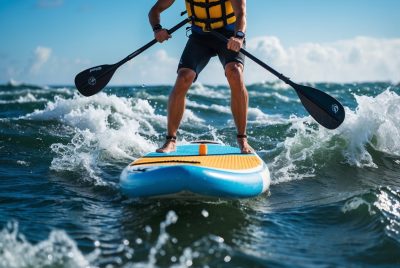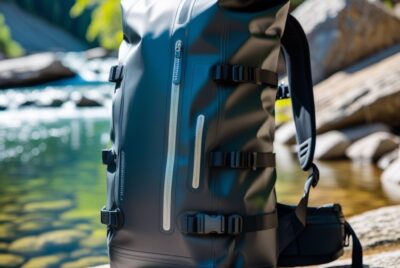Kayak Dock Essentials: Design for Easy Access
*We may earn a commission for purchases made using our links. Please see our disclosure to learn more.
Kayak Dock Essentials: Choosing the Right Design for Easy Access
As a kayaking enthusiast, I’m well aware of how getting in and out of a kayak can prove challenging, especially for beginners or in difficult environmental conditions. Traditional docks aren’t always designed with small, low-profile watercraft like kayaks and canoes in mind. This is where a specialized kayak dock provides a useful solution. These docks are designed to offer ease and stability when launching or returning from a paddle. A kayak dock typically sits closer to the waterline and includes features that help prevent the kayak from tipping, providing a safer and more straightforward experience.

In recent years, innovations in dock technology have made waterfront experiences more accessible. For instance, some models are equipped with floating dock systems that adjust to changing water levels, ensuring that the dock remains at an optimal height for kayak entry and exit. Others have one-piece construction, which enhances durability and minimizes the impact of stormy weather. The materials used in kayak docks also contribute to their functionality; many are constructed with polyethylene, offering resistance to rust and decay in both freshwater and saltwater environments. With additional features like non-slip surfaces and foam-filled floats, these docks not only enhance safety but also offer a maintenance-free solution to kayakers looking to maximize their time on the water.
Types of Kayak Docks

When I consider installing a kayak dock, I contemplate various dock types which cater to individual preferences and requirements. The choice largely depends on factors such as water conditions, space, and kayak type.
Floating Kayak Dock
I understand that floating kayak docks are an exceptional choice for areas with fluctuating water levels. Typically, these docks are constructed from low-density polyethylene, which provides durability and resistance to the elements. A common design incorporates foam-filled sections that enhance buoyancy and stability. For those who prioritize ease of access and adaptability, floating docks provide a versatile solution.
- Material: Low-density polyethylene for resilience.
- Design: Foam-filled for extra buoyancy.
Drive-On Docking
Drive-on docking systems offer an innovative way for me to launch and retrieve my kayak easily. These docks usually feature a one-piece construction, which ensures simplicity and robustness. The drive-on functionality is particularly suitable for single kayaks, allowing me to glide onto the dock without the need for lifting or dragging.
- Construction: One-piece for simplicity.
- Functionality: Designed to allow kayaks to drive on and off effortlessly.
Stationary Kayak Dock
If I’m dealing with calm and consistent water levels, stationary docks are a reliable permanent solution. These docks are firmly anchored to the seabed or shoreline, providing an unwavering platform irrespective of weather conditions. While they may require more initial work to install, their steadfastness is matchless.
- Installation: Anchored for a permanent placement.
- Stability: Resistant to varying weather without shifting.
Each dock type addresses distinct circumstantial needs, hence, as I explore my options, I’ll focus on functionality, maintenance, and integration with my waterfront environment.
Design and Durability

In my experience, the most successful kayak dock designs blend durability with low maintenance, ensuring both long-term resilience and ease of use. Here, I’ll discuss what factors contribute to these essential features.
Materials and Construction
When I consider the construction of a kayak dock, the choice of materials is critical. PVC and Low Density Polyethylene (LDPE) are commonly used due to their robustness and resistance to environmental stressors. These materials offer several advantages:
- Durability: Both materials are tough and capable of withstanding impact, making them ideal for docks.
- Cold Weather Resistance: LDPE has excellent performance in cold weather, ensuring the dock remains operational even in freezing temperatures.
- Maintenance: PVC and LDPE often require minimal upkeep due to their ability not to rot or corrode.
- Unsinkability: Their inherent buoyancy makes docks crafted from these materials virtually unsinkable, ensuring safety and longevity.
Maintenance and Longevity
For low or zero maintenance, I always look for docks that showcase designs that minimize upkeep. Here are the key points to consider:
- Resistance to Wear: A well-constructed dock should withstand frequent use as well as harsh weather conditions, including exposure to saltwater and UV rays.
- Ease of Cleaning: Surfaces should be smooth to discourage algae growth and easy to clean, typically requiring just soap and water.
- Material Endurance: Look for high-quality materials like PVC and LDPE that promise low maintenance without sacrificing durability; these materials don’t necessitate frequent repairs or replacements.
By meticulously selecting materials and ensuring a well-thought-out construction, a kayak dock can deliver on its promise of durability and low to zero maintenance, making it an investment that stands the test of time.
Accessibility and Ease of Use

Accessibility in kayak docks ensures that all kayakers, including those with disabilities, can safely and easily access the water. My focus here is on the stability and safety features of the dock, as well as the entry and exit strategies that cater to the needs of diverse users, from novice to expert.
Stability and Safety Features
Stability is paramount when it comes to kayak docks. I look for docks that are designed to minimize movement, which instills confidence, especially in novice kayakers. The proper use of floatation accessories can significantly enhance stability. Moreover, the inclusion of handrails can provide additional balance and support, making the docks more user-friendly for individuals with limited mobility.
- Safety Features to Consider:
- Non-slip surfaces: Essential for preventing falls.
- Handrails: Offer support when boarding and exiting.
- Paddle notches: Secure paddles, preventing them from falling into the water.
Entry and Exit Strategies
The ease with which one can enter and exit a kayak is critical. The EZ Launch® System is a beneficial feature as it simplifies the process for kayakers, making it more intuitive and less physically demanding. Docks that feature a transfer slide bench with a grab rail can assist users in smoothly transitioning from wheelchair to kayak.
- Entry and Exit Considerations:
- Low profile designs: Aid in easier kayak alignment.
- Z Bracket Kit: Helps in attaching accessories for customized needs.
In designing docks, I prioritize features that accommodate a diverse range of kayaking enthusiasts, ensuring that docks are not only accessible but also provide a satisfying experience for all users.
Additional Considerations for a Kayak Dock

When outfitting my dock for kayaks, I consider storage solutions and dock configurations that enhance my watercraft management. My focus is on ensuring a seamless and worry-free experience.
Storage Solutions
My kayak storage approach prioritizes space efficiency and ease of access. Here’s what I’ve found useful:
- Rack Systems: I attach racks to the side of the dock, which saves space and keeps kayaks within easy reach. These racks often include straps to secure the kayaks, ensuring they stay put even in windy conditions.
- Dock Boxes: A dock box provides a convenient place to store paddles and life vests. I make sure it’s waterproof and lockable for security.
I pay special attention to the capacity of storage solutions, ensuring they can handle everything from kayaks to paddle boards.
Dock Configurations and Customization
The design of the docking area is crucial for its functionality. Here’s what I consider:
- Dock Size and Shape: My dock’s design accommodates kayaks, canoes, and paddle boards, ensuring enough surface area for safe boarding and disembarking.
- Material Choices: I opt for materials like aluminum for its strength-to-weight ratio and rust resistance, ensuring longevity.
- Accessories: Accessories such as paddle notches on the dock edges help me with stable entry and exit.
Customization options allow me to tailor the configuration to my residential needs, balancing aesthetics with utility.
Frequently Asked Questions

As an expert on kayak docks, I’m here to answer the most commonly asked questions to help ensure that your experiences on the water are both enjoyable and safe.
1. What are the main benefits of using a kayak launcher?
Kayak launchers provide stability and ease for entering and exiting your kayak. They keep the kayak steady, which can be particularly helpful for individuals with limited mobility or those new to kayaking.
2. What is the most secure way to tie a kayak to a dock?
The most secure method is to use dock lines with either a bowline knot or a figure-eight follow-through knot, attaching your kayak to cleats or rings on the dock that are designed for securing boats.
3. How does a kayak dock differ from a traditional boat dock?
Unlike traditional docks, kayak docks are lower to the water and often include features like a slip-resistant surface and a mechanism for easy launching and docking, tailored to the lightweight and specific dimensions of kayaks.
4. What are safety considerations when using a kayak dock?
Always ensure the dock is free of obstructions and the launch path is clear; use assistance when docking in challenging conditions; and wear appropriate personal flotation devices at all times.
5. What materials are kayak docks typically made from?
Kayak docks are often constructed from polyethylene, aluminum or wood. These materials are chosen for their durability, buoyancy, and resistance to corrosion, especially the polyethylene in salt water environments.




